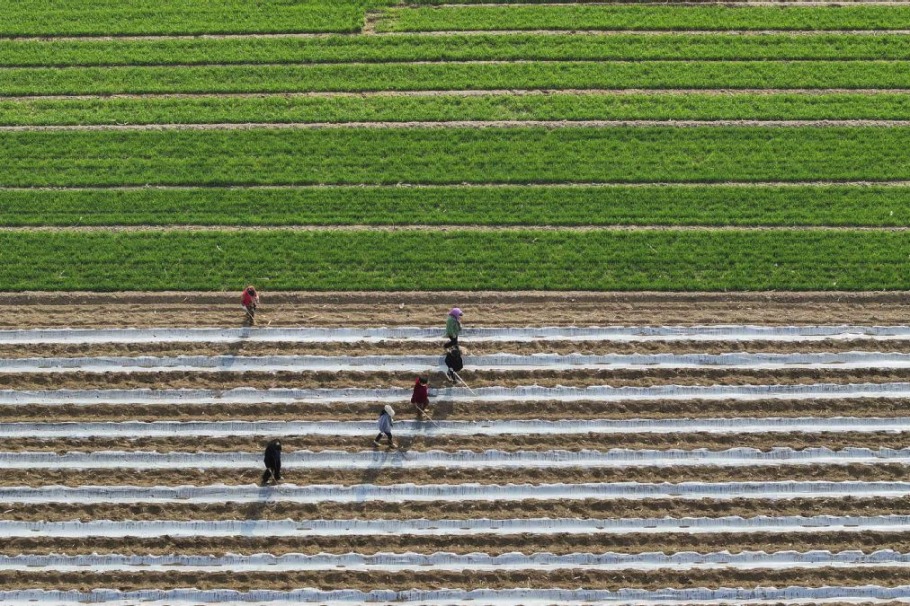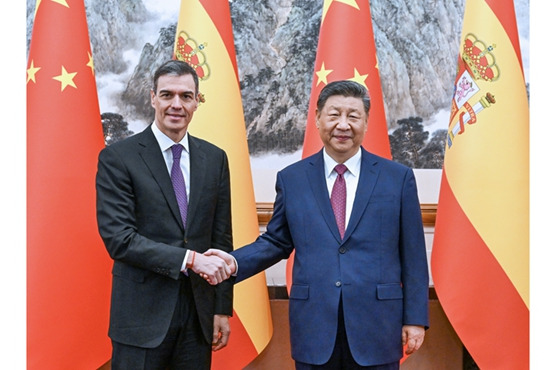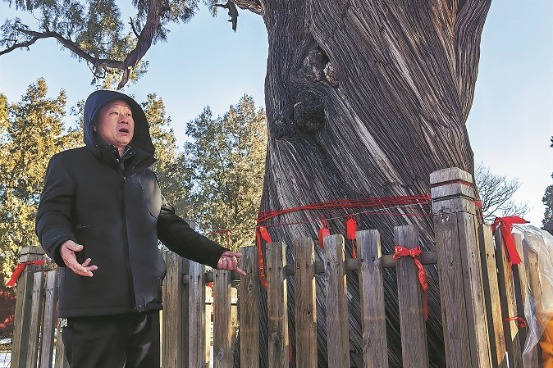Nation forges ahead with climate actions


Commitments on issue honored at home and abroad
Editor's note: A survey among China Daily's overseas readers ahead of the 20th National Congress of the Communist Party of China shows that the nation's ecological progress, economy, diplomacy, science and technology, and the Belt and Road Initiative are among some of the most closely observed issues. Starting today, China Daily will publish a series of special articles to offer readers an in-depth look at these topics.
An intriguing cross-shaped skylight sits atop Hangzhou West Railway Station in the capital of Zhejiang province, giving the structure a truly modern appearance.
Covering 12,500 square meters, the skylight allows sunlight to reach a subway station under the 57-meter-high building, significantly reducing electricity consumption needed for lighting.
Although overshadowed by the blue skylight, the black section of the complex's huge roof has more roles to play than merely keeping the wind and rain out. Comprising 7,540 photovoltaic modules, it can generate more than 2.3 million kilowatt-hours of electricity a year, helping avoid 2,300 metric tons of carbon dioxide emissions.
Moreover, thanks to a type of high-tech material, the roof can reflect heat, which means reduced energy consumption for air conditioning in the complex with a total floor area of 510,000 square meters, equivalent to more than 71 standard-size soccer pitches.
Designed and constructed by adopting a low-carbon philosophy, the structure is an official top-level green building.
President Xi Jinping announced in September 2020 that China aims to peak carbon dioxide emissions before 2030 and achieve carbon neutrality before 2060.
At an international event in 2020, he stressed that China always honors its commitments. "We will take solid steps to implement the targets just announced, and contribute even more to tackling the global climate challenge," Xi said.
China's actions at home and abroad show that it has kept its word.
As China forges ahead with its climate targets, the public has been inundated with a ceaseless flow of news about the country's climate actions.
Hangzhou West Railway Station, which opened last month, is just one project to hit the headlines as numerous documents are introduced at national and regional level to cope with the global climate crisis.
Climate action has not only been taken in bustling urban centers such as Hangzhou, but also in the nation's vast offshore areas, sparsely populated mountainous regions, and even remote deserts. Overseas, pragmatic cooperation programs have been introduced to help other developing nations with their climate endeavors.
Efforts praised
Liu Dechun, an official at the National Development and Reform Commission, or NDRC, the nation's top economic planner, said at a recent news conference, "Over the past two years, under the strong leadership of the Communist Party of China Central Committee with Comrade Xi Jinping at its core, the country has got off to a good start for its dual climate targets thanks to the efforts of different regions and government bodies in pragmatically promoting related work."
China's top-level design for these targets — dubbed the "1+N" policy system — was cited by Liu as an example of such progress.
The "1" in the system refers to a master guideline issued by the CPC Central Committee and the State Council, China's Cabinet, as an overarching guide for the targets, while the "N" refers to a series of specific action plans for different industrial sectors and supporting policies.
Liu said: "Relevant government bodies have hammered out implementation plans for different sectors and industries, as well as supporting policies. Provincial-level regions have also worked out their implementation plans to peak carbon dioxide emissions."
For example, one of the action plans concerns the low-carbon transition in the construction sector, which is a major carbon dioxide emitter nationwide. Issued by the NDRC and the Ministry of Housing and Urban-Rural Development in July to peak carbon dioxide emissions in the sector, the plan laid out key specific targets for energy conservation and the use of solar energy generation facilities in buildings.
According to the China Association of Building Energy Efficiency, greenhouse gases emitted in the entire building process from producing materials to building and operating was equivalent to 4.9 billion metric tons of carbon dioxide in 2018, more than half the total emissions that year.
Energy-saving transformations are expected to be completed in all public buildings in major cities across China by 2030, typically increasing energy efficiency by at least 20 percent.
By 2025, photovoltaic panels will be installed at half of all newly constructed public buildings and factories nationwide, according to the action plan, which states that such panels will be added to more existing buildings.
China has also made efforts to tap the potential of renewable energy development in offshore areas and deserts. For instance, the NDRC announced in May that the nation plans to build 450 million kWs of solar and wind power generation capacity in the Gobi and other desert regions.
As one of the supporting policies for climate actions, the People's Bank of China, the nation's central bank, introduced a monetary policy tool late last year to back projects that reduce carbon dioxide emissions. The policy tool enables financial institutions to benefit from cheap loans.
China has experienced robust growth in green finance in the past two years, according to the bank.
As of the end of last year, the nation's domestic and foreign currency green loan balance stood at 15.9 trillion yuan ($2.24 trillion), up by 33 percent from the previous year. Following a rise of 180 percent from 2020, more than 600 billion yuan of green bonds was issued in China last year, making it the second-largest green bond market globally.
Li Jing, partner of climate change and sustainability services at Ernst & Young Greater China, said the nation's green finance market is in full swing. She expects more overseas investment in green finance products in China, such as green bonds and carbon-neutrality exchange-traded funds.
Xie Zhenhua, China's special envoy for climate change, said at a recent symposium, "The nation faces huge challenges to realize its climate targets, but systematic low-carbon transition will create huge market and investment opportunities for technological development and innovation."
He stressed that climate actions will also help synergize efforts to bolster the economy, employment, energy development, food production, healthcare and environmental conservation.
According to the Ministry of Ecology and Environment, China's carbon emission intensity — the amount of carbon dioxide emissions produced per unit of GDP — fell by 3.8 percent last year from 2020. "China has essentially reversed the rapid growth of its carbon dioxide emissions," the ministry said.
The nation's hydropower, wind power, solar power and biomass power capacities all rank first globally.
In addition to measures to mitigate climate change, the nation has moved toward climate adaptation.
Liu Youbin, spokesman at the Ministry of Ecology and Environment, said, "China always attaches equal importance to climate mitigation and adaptation by implementing a national strategy of actively responding to climate change."
In June, 17 government departments, including the ministry, jointly released a new national strategy on climate adaptation. The document pledged to make significant improvements to the nation's ability to adapt to climate change, and basically build a climate-resilient society by 2035.
Liu said the ministry also recently published a guideline to help governments at provincial level draft their climate adaptation plans.
Overseas measures
While promoting climate action at home, China has also announced a series of actions to shoulder its responsibility for building a global community with a shared future.
In September last year, President Xi announced that China would step up support for other developing countries in advancing green and low-carbon energy, and would not build new coal-fired power projects overseas.
Early this year, to further promote green development as part of the Belt and Road Initiative, the Ministry of Ecology and Environment and the Ministry of Commerce updated a 2013 guideline on environmental protection in overseas operations. Chinese companies were asked to adhere to environmentally friendly approaches for their projects from start to finish.
With climate change one of the major concerns, the document includes environment-related requirements for wide-ranging procedures in companies' overseas operations. For example, before overseas mergers and acquisitions, Chinese enterprises should assess environmental risks caused by target companies, and greenhouse gas emissions should be given priority in the assessment.
The guideline explicitly states that priority should be given to renewable energy when Chinese companies develop energy projects.
The nation has also made consistent efforts to help other developing countries with their climate actions through South-South cooperation.
According to the Ministry of Ecology and Environment, China has reached 43 agreements with 38 countries through South-South climate cooperation. Apart from allocating 1.2 billion yuan for such cooperation, China has offered training programs to some 2,000 officials and technicians working in climate-related positions in 120 countries.
On Sep 29, for example, China handed to Uruguay a mobile ground system that can receive and process data from meteorological satellites. The equipment is expected to improve the South American nation's ability to cope with climate change by enhancing meteorological monitoring.
At a news conference in September, Minister of Ecology and Environment Huang Runqiu stressed that China is determined to achieve its climate targets. He said these goals are "a natural choice to achieve sustained development of the Chinese nation "and "a solemn commitment to building a shared future for mankind".
China will honor its promises with concrete action, he said.
"While fully implementing the '1+N'policy for peaking carbon dioxide emissions and realizing carbon neutrality, we will actively take part in and lead global climate governance to make new, even greater contributions to build a Beautiful China and cope with climate change," Huang added.
- China renews several alerts for gales, sandstorms, blizzards
- China, Vietnam to conduct joint patrol in Beibu Gulf
- Tradition, tea, and tomorrow: Xi's stories with Vietnam
- Governor of Shanxi under probe
- Beijing handles over 800 fallen trees due to strong winds
- Beijing airport cancels over 400 flights due to strong winds



































